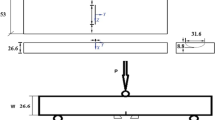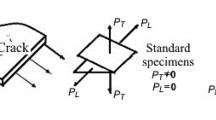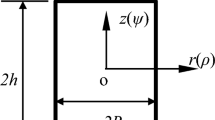Abstract
The possibility of assessing the fracture resistance of brittle materials by testing short cylinders, solid and with a central hole, under diametral compression has been investigated. The computational analysis was performed using the finite element method with the ANSYS program. It was shown that the stress distribution in a disk with a hole is similar to that in a disk without a hole, but it has disturbances caused by the stress concentrator in the form of the hole. The normalized values of the maximum principal stresses for a disk with a hole are more than 5 times higher than those for a disk without a hole. Experimental analysis was carried out by testing short cylinders made of brittle materials—cast iron and graphite—both solid and with a central hole. It was found that the fracture resistance determined by the formula of the ASTM D3967-95a standard is practically the same for solid cast iron specimens, while for graphite specimens it differs by 1.5 times from the true fracture resistance of the materials. When testing specimens of cast iron and graphite with a central hole, the fracture resistance differs from the standard by 1.5 and almost 2.5 times, respectively. The different nature of specimen failure was also noted—slow controlled fracture for cast iron and dynamic fracture for graphite, according to their respective deformation diagrams. As an example, the results of testing real cylindrical specimens with a central hole—uranium dioxide fuel pellets—are presented. It is shown that the results of testing graphite ARV-1 specimens and fuel pellets are in good agreement. Thus, the possibility of testing small short cylinders using the diametral compression scheme for indirect assessment of tensile strength of brittle materials is confirmed. A calculation equation is proposed for the indirect assessment of the tensile strength of brittle materials based on the results of testing small short cylinders with and without a central hole under diametral compression.
Similar content being viewed by others
Avoid common mistakes on your manuscript.
INTRODUCTION
In order to assess the tensile breaking strength of low-plasticity materials, an increasingly popular method is the testing of short cylinders (thick disks) using the diametral compression scheme [1–16]. Tests are carried out in accordance with the ASTM D3967-95a standard, which is designed for testing specimens of rocks [17, 18]. The diameter of the rock specimens is taken as 50 mm, with a thickness ranging from 0.2 to 0.75 of the diameter.
The possibility of using this method for testing small-sized short cylinders with a central hole to determine the strength of brittle materials such as carbides and nitrides has been investigated in this study. This method has proven to be particularly important for evaluating the strength of materials obtained by electric pulse consolidation of powders [19–21].
DESIGN ANALYSIS OF LOADING A DISK WITH AND WITHOUT A CENTRAL HOLE USING THE DIAMETRAL COMPRESSION SCHEME
A detailed analytical analysis of loading a small-sized solid disk using the diametral compression scheme (Brazilian test) is presented in [22]. It is shown that, under this loading scheme of a disk specimen in its diametral plane, tensile stresses occur, leading to brittle fracture of low-plasticity materials. The resistance of the material to fracture is calculated using the equation recommended by the ASTM D3967-95a standard:
where P is the maximum load at specimen breakage, and L and D are the thickness and diameter of specimen, respectively.
Comparison of diametral compression of a disk specimen with and without a central hole was conducted using the finite element method with the ANSYS Mechanical software package [23, 24]. The dimensions of the disks were assumed to be the same: thickness of 4 mm and diameter of 7.2 mm. In the specimen with a hole, the diameter of the central hole was 1.1 mm. It was shown that the stress distributions in the disk with and without the hole are similar, but in the former case, disturbances caused by the stress concentrator in the form of the hole are present. A distinct stress concentration zone is observed along the contour of the hole, with significantly higher stress values than the average. Normalized values of the maximum principal stresses for the disk with a hole exceed those for the disk without a hole by more than five times.
EXPERIMENTAL ANALYSIS OF THE DIAMETRAL COMPRESSION TEST ON BRITTLE DISKS WITH A CENTRAL HOLE
For the diametral compression test, brittle materials were selected: gray cast iron SCh 10 (according GOST 1412) and graphite ARV-1. The mechanical properties of these materials are summarized in Table 1.
Tests of solid short cylinders made of gray cast iron. The tested specimens with sizes of D × L, where D is the specimen diameter and L is the specimen length, were loaded on an INSTRON testing machine using a special device that ensured strict parallelism of the stamp planes. Simultaneously with the loading, deformation of surface points of each specimen was recorded using the digital image correlation (DIC) method [25, 26].
Table 2 shows the results of testing five short cylinders made of cast iron with dimensions of 10 × 4 mm: the maximum loads corresponding to the beginning of the failure of all tested specimens and the breaking stresses calculated according to Eq. (1) and the equation below:
The coincidence of the destructive stress determined by Eq. (1) with the strength of the material under tension confirms the possibility of using this equation for materials such as cast iron, which have a machine diagram of disk compression shown in Fig. 1.
The initiation of crack growth is associated with the maximum load on the specimen. The gradual decrease in load after the maximum: slow propagation of the crack and separation of one half of the specimen from the other. There is no explosive destruction characteristic of brittle fracture under normal stresses. The interruption of the diagram at this load level is associated with the cessation of the specimen deformation process. The stepped fracture in the diametrical plane of the disk indicates that the specimen rupture occurs under the action of tangential stresses.
Tests of solid short cylinders with a central hole made of gray cast iron. The sizes of the cylinders with central hole made of gray cast iron are as follows: diameter D = 7.2 mm, thickness L = 4 mm, diameter of central hole d = 1.2 mm.
The failure of the cylinder with the hole occurred in the diametral plane along the loading line and began from the central hole. The nature of fracture is similar to the process of fracture of continuous specimens, i.e., slow controlled crack propagation.
Table 3 shows the test results of specimens with a central hole. The resistance of the material to fracture σth and S1 was calculated according to the following equations:
and
The resistance of cast iron specimens to destruction turned out to be 1.5 times lower than the true mechanical characteristic (see Table 1). This effect of reducing the resistance of the material to destruction during testing of the specimen is associated with stress concentration at the central hole.
Thus, unlike a solid cylinder, the destruction of a cylinder with a central hole starts from this hole. In all other aspects, the behavior of cylinders with holes and solid ones was similar. There was no explosive destruction characteristic of brittle fracture under normal stresses. Slow separation of one half of the specimen from the other was observed, which is typically associated with plastic deformation.
The deformation diagrams of the examined specimens were also similar.
Tests of solid short cylinders made of graphite. The graphite cylinders had the following standard sizes D × L: 8 × 4, 8 × 8, and 8 × 12 mm. A characteristic compression diagram of a graphite disk 8 × 8 mm in the diametral plane is shown in Fig. 2.
The destruction of the graphite cylinder occurred dynamically on a practically linear section of the diagram at maximum load, with the specimen sometimes splitting into several fragments. Initial cracks were also detected in the contact area of the specimen, which served as a source of failure of the specimen.
Table 4 presents the values of the resistance to destruction of graphite specimens calculated using Eqs. (1) and (2). It can be seen that the average value of the resistance to graphite destruction calculated by Eq. (1) increases by approximately 10% with a doubling of the thickness of the specimen. However, σt turned out to be almost half of the true value (see Table 1), which is due to the more brittle state of graphite compared to cast iron. This is also evidenced by the differences in compression diagrams of specimens made of cast iron and graphite.
Tests of solid short cylinders with central hole made of graphite. The cylinders with a central hole made of graphite had the same dimensions as the solid specimens; for all disks, the diameter of the central hole is 1 mm. Table 5 shows the results of their testing.
The compression diagram of graphite specimens with a central hole is linear up to brittle fracture, similar to specimens without a hole. The specimens fractured completely brittlely in the diametral plane of the disk. The destruction started from the central hole. In addition to the diametral cracks, some specimens showed several extra cracks, typical of brittle fracture, accompanied by a large number of fragments.
The average tensile strength calculated by Eq. (1) for specimens with a central hole was found to be 2.7 times lower than the true value (see Table 1). In comparison to cast iron, the presence of a central hole in a graphite specimen reduces the breaking stress by more than 1.5 times. This can be explained by the fact that graphite is a more brittle material than cast iron and therefore more sensitive to stress concentrations. This is also confirmed by the difference in deformation diagrams of cast iron and graphite specimens (see Figs. 1 and 2).
Tests of uranium dioxide fuel pellets with central hole. As an example, specimens of an actual real design in the form of a small cylinder with a central hole, uranium dioxide fuel pellets, were tested according to the diametral compression scheme. The diameter of the central hole is 1.1 mm. The dimensions of the specimens and the results of their testing are given in Table 6.
The nearly linear increase in load up to brittle failure of the specimens should be mentioned, similar to that obtained in tests of graphite specimens. The nature of the fuel pellet fracture is similar to the characteristics of graphite specimen fractures: completely brittle failure in the diametral plane of the disk along the load line, originating from the central hole. Simultaneously, two cracks formed from the area of maximum tangential stresses. The experimental results demonstrated the possibility of testing a real brittle structure using the diametral compression scheme with an indirect assessment of the resistance of the material to brittle failure. The level of destructive stresses for the fuel pellets aligns well with the values of destructive stress for graphite specimens, and the calculated strength level aligns with the true tensile strength of ARV-1 graphite.
Thus, the results of testing specimens using the diametral compression scheme, having a linear machine compression diagram similar to the diagram of testing graphite specimens, can be used to formulate a calculation equation for assessing material strength under tension. The true resistance of the material to rupture should be evaluated using the equation
according to testing of solid specimens or
according to testing of specimens with central hole.
CONCLUSIONS
The results of the analytical and experimental analysis of the behavior of quasi-plastic (cast iron) and brittle (graphite) materials under diametral compression of short cylindrical specimens (disks) are presented, indicating a significant and different influence of stress concentration. The presence of a central hole in the disk significantly reduces the strength under diametral compression if the material demonstrates brittle failure (on the linear portion of the deformation curve) and to a lesser extent if the material exhibits plastic properties. The fracture resistance determined by the formula recommended by ASTM D3967-95a standard for solid cast iron specimens is practically the same, while for graphite it differs by 1.5 times from the true strength of the materials. When testing specimens with a central hole, the fracture resistance differs from the true strength of the materials by 1.5 and almost 2.5 times, respectively. The possibility of testing nuclear fuel (fuel pellets) using the diametral compression scheme with an indirect assessment of resistance of the material to brittle failure has been demonstrated.
REFERENCES
Rodriguez, J., Navarro, C., and Sanchez-Galvez, V., Splitting tests: An alternative to determine the dynamic tensile strength of ceramic materials, J. Phys. IV Coll., 1994, no. 04 (C8), pp. 101–106. https://doi.org/10.1051/jp4:1994815
Bell, F.G., Rock properties and their assessment, in Encyclopedia of Geology, Selley, R.C., Ed., Amsterdam: Elsevier, 2005, pp. 566–580. https://doi.org/10.1016/b0-12-369396-9/00211-2
Drouet, C., Largeot, C., Raimbeaux, G., Estournès, C., Dechambre, G., Combes, C., and Rey, C., Bioceramics: Spark plasma sintering (SPS) of calcium phosphates, Adv. Sci. Technol., 2006, vol. 49, pp. 45–50. https://doi.org/10.4028/www.scientific.net/AST.49.45
Proveti J.R.C. and Michot, G., The Brazilian test: A tool for measuring the toughness of a material and its brittle to ductile transition, Int. J. Fract., 2006, vol. 139, pp. 455–460. https://doi.org/10.1007/s10704-006-0067-6
Akhtar, F., Vasiliev, P.O., and Bergström, L., Hierarchically porous ceramics from diatomite powders by pulsed current processing, J. Am. Ceram. Soc., 2009, vol. 92, no. 2, pp. 338–343. https://doi.org/10.1111/j.1551-2916.2008.02882.x
Es-Saheb, M.H., Albedah, A., and Benyahia, F., Diametral compression test: Validation using finite element analysis, Int. J. Adv. Manuf. Technol., 2011, vol. 57, pp. 501–509. https://doi.org/10.1007/s00170-011-3328-0
Bragov, A.M., Konstantinov, A.Y., Lamzin, D.A., Lomunov, A.K., and Filippov, A.R., Dynamic deformation and destruction of brittle structurally inhomogeneous media, Probl. Prochn. Plast., 2012, no. 74, pp. 59–67.
Molotnikov, V.Ya. and Molotnikova, A.A., Notes on the Brazilian method for studying the tensile strength of brittle materials, Vestn. DGTU, 2014, vol. 14, no. 4 (79), pp. 30–38. https://doi.org/10.12737/6889
Zaytsev, D. and Panfilov, P., Deformation behavior of human dentin in liquid nitrogen: A diametral compression test, Mater. Sci. Eng., 2014, vol. 42, pp. 48–51. https://doi.org/10.1016/j.msec.2014.05.011
Patil, S.G., Sajjan, M.S., and Patil, R., The effect of temperature on compressive and tensile strengths of commonly used luting cements: An in vitro study, J. Int. Oral Health., 2015, vol. 7, no. 2, pp. 13–19.
Mazel, V., Guerard, S., Croquelois, B., Kopp J.-B., Girardot, J., Harona, D., Busignies, V., and Tchoreloff, P., Reevaluation of the diametral compression test for tablets using the flattened disc geometry, Int. J. Pharm., 2016, vol. 513, nos. 1–2, pp. 669–677. https://doi.org/10.1016/j.ijpharm.2016.09.088
Rocha J.A.L. and Wahrhaftig, A.M., Superposition of stress fields in diametrically compressed cylinders, Latin Am. J. Solids Struct., 2016, vol. 13, pp. 1954–1967. https://doi.org/0.1590/1679-782526
Zaitsev, D.V., Kochanov, A.N., Toktogulov, Sh.Zh., Panteleev, I.A., and Panfilov, P.E., Influence of the scale effect and heterogeneity of displaced rocks in determining their strength properties, Gorn. Inf.-Anal. Byull., 2016, no. 11, pp. 208–215.
Markides, C.F. and Kourkoulis, S.K., Parametric study of the deformation of transversely isotropic discs under diametral compression, Fratt. Integr. Strutt., 2017, vol. 41, pp. 396–411. https://doi.org/10.3221/IGF-ESIS.41.51
Horynová, M., Casas-Luna, M., Montufar, E.B., Diaz-dela-Torre, S., Celko, L., Klakurková, L., Diéguez-Trejo, G., Dvorak, K., Zikmund, T., and Kaiser, J., Fracture mechanism of interpenetrating iron-tricalcium phosphate composite, Solid State Phenom., 2017, vol. 258, pp. 333–336. https://doi.org/10.4028/www.scientific.net/SSP.258.333
Luginina, M., Orru, R., Cao, G., Grossin, D., Brouillet, F., et al., First successful stabilization of consolidated amorphous calcium phosphate (ACP) by cold sintering: Toward highlyresorbable reactive bioceramics, J. Mater. Chem. B, 2020, vol. 8, no. 4, pp. 629–635. https://doi.org/10.1039/c9tb02121c
ASTM D3967-95a: Standard Test Method for Splitting Tensile Strength of Intact Rock Core Specimens.
Wang, Q.Z., Jiaa, X.M., Koub, S.Q., Zhangh, Z.X., and Lindgvistg, P.A., Int. J. Rock Mech. Mining Sci., 2004, vol. 41, no. 2, pp. 245–253.
Grigoriev, E.G. and Rosliakov, A.V., Electro-discharge compaction of WC-Co and W-Ni-Fe-Co composite materials, J. Mater. Process. Technol., 2007, vol. 191, nos. 1–3, pp. 182–184. https://doi.org/10.1016/j.jmatprotec.2007.03.016
Smirnov, K.L., Grigoryev, E.G., and Nefedova, E.V., SiAlON-TiN ceramic composites by electric current assisted sintering, Mater. Sci. Forum, 2019, vol. 946, pp. 53–57. https://doi.org/10.4028/www.scientific.net/MSF.946.53
Klyatskina, E.A., Borrell, A., Grigoriev, E.G., Zholnin, A.G., Salvador, M.D., and Stolyarov, V.V., Structure features and properties of graphene Al2O3 composite, J. Ceram. Sci. Technol., 2018, vol. 9, no. 3, pp. 215–224. https://doi.org/10.4416/JCST2018-00006
Goltsev, V.Y., Osintsev, A.V., and Plotnikov, A.S., Lett. Mater., 2017, vol. 7, no. 1, pp. 21–25. https://doi.org/10.22226/2410-3535-2017-1-21-25
ANSYS Inc., Release 16.2 Documentation for ANSYS.
NAFEMS Ltd., NAFEMS Search Engineering Analysis and Simulation of Finite Element Analysis, Computational Fluid Dynamics, and Simulation.
Sutton, M.A., Orteu, J.J., and Schreier, H.W., Image Correlation for Shape, Motion and Deformation Measurements: Basic Concepts, Theory and Applications, New York: Springer, 2009, p. 321.
Chu, T.C., Ranson, W.F., Sutton, M.A., and Peters, W.H., Exp. Mech., 1985, vol. 25, no. 3, pp. 232–245.
Funding
This work was supported by the program of competitive growth of the National Research Nuclear University MEPhI.
Author information
Authors and Affiliations
Corresponding author
Ethics declarations
The authors of this work declare that they have no conflicts of interest.
Additional information
Translated by I. Moshkin
Publisher’s Note.
Pleiades Publishing remains neutral with regard to jurisdictional claims in published maps and institutional affiliations.
Rights and permissions
About this article
Cite this article
Goltsev, V.Y., Osintsev, A.V., Plotnikov, A.S. et al. Diametral Compression of Short Cylinders with a Central Hole as a Method for Assessing the Tensile Strength of Brittle Materials. Inorg Mater (2024). https://doi.org/10.1134/S0020168524700201
Received:
Revised:
Accepted:
Published:
DOI: https://doi.org/10.1134/S0020168524700201






